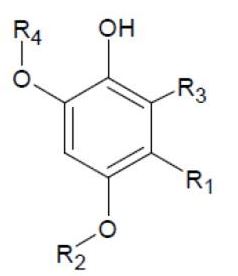
The present solution relates to halogenated alkyl-aromatic secondary metabolites, in particular hierridin C from the cyanobacterium Cyanobium sp. LEGE 06113 and its application as an antimalarial and anticancer agents. Furthermore, the present disclosure also relates to methods to obtain the compound from the Cyanobium sp. LEGE 06113 and to methods to chemically synthetize hierridin C and its derivatives under laboratory conditions.
Malaria is present in more than one hundred countries and according to the World Health Organization, 198 million deaths were the result of malaria infection, in 2013. Presently, there is a growing need for antimalarial agents, either for monotherapy or as multi-drug therapies as drug-resistant strains are emerging worldwide, in particular mefloquine and chloroquine resistant strains. Therefore, new agents able to kill the resistant malaria parasites are warranted.
The solution now disclosed relates to antimalarial agents and to methods to obtain them. The advantage of the present disclosure is that there is no strain of P. falciparum known to be resistant to halogenated alkyl-aromatic secondary metabolite, in particular hierridin C and its derivatives. This advantage is relevant as death by malaria is almost exclusively caused by P. falciparum.
Furthermore, the solution herein presented relates to processes used to obtain this compound from the cyanobacterial cultures; furthermore it also relates to compounds sharing the same halogenated skeleton as hierridin C, and to its use in formulations for treating, preventing or inhibiting malaria in humans.
The hierridin C is a new antimalarial agent, which can be used to treat malaria, one of the most prevalent and life threatening infectious diseases in the developing world. It is a natural product and can be obtained from a renewable, photoautotrophic source by mass culturing in the laboratory or open ponds
Pharmaceutical products and drugs
A proteção dos direitos de propriedade industrial é cofinanciada por:






